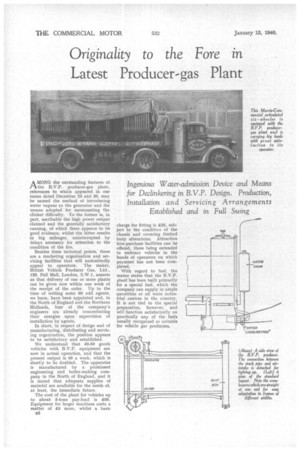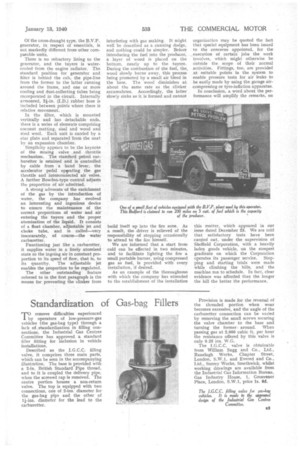Originality to the Fore in Latest Producer-gas Plant
Page 28

Page 29

If you've noticed an error in this article please click here to report it so we can fix it.
AMONG the outstanding features of the B.V.P. producer-gas plant, references to whicn appeared in our issues dated December 23 and 30, may be named the method of introducing water vapour to the generator and the means adopted for surmounting the clinker difficulty, To the former is, in part, ascribable the high power output claimed and the generally satisfactory running, of which there appears to be good evidence, whilst the latter results in big mileages, uninterrupted by delays necessary for attention to the condition of the fire.
Besides these technical points, there are a marketing organization and servicing facilities that will undoubtedly appeal to operators. The maker, British Vehicle Producer Gas, Ltd,, 120, Pall Mall, London, S.W.1, assures us that delivery of one or more plants can be given now within one week of the receipt of the order. Up to the time of writing some 60 odd agents, we learn, have been. appointed and, in the North of England and the Northern • Midlands, four of the company's engineers are already concentrating their energies upon supervision of installation by agents.
In short, in respect of design and of manufacturing, distributing and servicing organization, the position appears to be satisfactory and established.
We understand that 40-50 goods vehicles with B.V.P. equipment are now in actual operation, and that the present output is 50 a week, which is shortly to be doubled. The apparatus is manufactured by a prominent engineering and boiler-making company in the North of England, and it is stated that adequate supplies of material are available for the needs of, at least, the immediate future,
The cost of the plant for vehicles up to about 5-tons pay-load is £95. Equipment for larger machines costs a matter of £5 more, whilst a basic
s2 charge for fitting is £25, subject to the condition of the chassis and covering limited body alterations. Attractive hire-purchase facilities can be offered, these being extended to embrace vehicles in the hands of operators on which payment has not been completed.
With regard to fuel, the maker states that the B.V.P. plant has been built primarily for a special fuel: which the company can supply in ample quantities at all main industrial centres in the country. It is not tied to the special preparation, however, and will function satisfactorily on practically any of the fuels usually recognized as suitable for vehicle gas producers. Of the cross-draught type, the B.V.P. generator, in respect of essentials, is not markedly different from other comparable units.
There is no refractory lining to the generator, and the tuyere is watercooled from the engine radiator. The standard position for generator and filter is behind the cab, the pipe-line from the former to the latter running around the frame, and one or more cooling and dust-collecting tubes being incorporated in the circuit. Internally armoured, 2i-in. (I.D,) rubber hose is included between points where there is relative movement.
In the filter, which is mounted vertically and has detachable ends, there is a series of elements comprising coconut matting, sisal and wood and steel wool. Each unit is carried by a .star plate and separated from the next by an expansion chamber.
Simplicity appears to be the keynote of the mixing valve and throttle mechanism. The standard petrol carburetter is retained and is controlled by cable from a hand lever, the accelerator pedal operating the gas throttle and interconnected air valve. A further Bowden-type control adjusts the proportion of air admitted.
A strong advocate of the enrichment of the gas by the introduction of water, the company has evolved an interesting and ingenious device to ensure the maintenance of the correct proportions of water and air entering the tapers and the proper atomization of the liquid. It consists of a float chamber, adjustable jet and choke tube, and is called—very inaccurately, of course—the water carburetter.
Functioning just like a carburetter, it supplies water in a finely atomized state to the in going air in constant proportion to its speed of flow, that is, to its quantity. The adjustable jet enables the proportion to be regulated.
The other outstanding feature referred to in the first paragraph is the means for preventing the clinker from
interfering with gas making. It might well be described as a cunning dodge, and. nothing could be simpler. Before introducing the fuel into the producer, a. layer of wood is placed on the bottom, nearly up to the tuyere. During the combustion of the fuel, the, wood slowly burns away, this process being promoted by a small air bleed in the base. The wood diminishes at about the same rate as the clinker accumulates. Accordingly, the latter slow)/ sinks as it is formed and cannot
build itself up into the fire zone. As a result, the driver is relieved of the responsibility of stopping occasionally to attend to the fire himself.
We are informed that a start from cold can be effected in two minutes, and to facilitate lighting the fire a small portable burner, using compressed gas as fuel, is provided with every installation, if desired.
As an example of the thoroughness with which the company has attended to the establishment of the installation organization may be quoted the fact that special equipment has been issued to the concerns apuointed, for the execution of certain jobs the work involves, which might otherwise be outside the scope of their normal activities. Fittings, too, are provided at suitable points in the system to enable pressure tests for air leaks to be easily made by using the garage aircompressing or tyre-inflation apparatus.
In conclusion, a word about the performance will amplify the remarks, on this matter, which appeared in our issue dated December 28. We are told that satisfactory tests have been carried out, under the supervision of Sheffield Corporation, with a heavily laden goods vehicle, on the steepest gradients on which the Corporation operates its passenger service. Stopping and starting trials were made while climbing the hills, and the machine ran to schedule. In fact, clear evidence was afforded that the longer the hill the better the performance.




























































